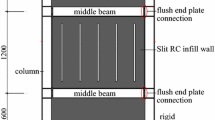Abstract
Steel frame and shear wall infill steel frame are two commonly lateral load resisting systems used in building structures. To realize the modulation of initial stiffness of steel structures, make it easily assembled and removed and prevent plastic hinges developing in the frame columns and collapse of all structure, a new anti-seismic infill wall system, composite steel plate deep beam (CDB), is introduced. The system uses steel plate deep beam with a precast reinforced concrete panel attached one side. This paper describes the experimental work related to the tests of CDB under cyclic loads. The experimental results of one pure steel frame (PF) and two composite steel plate deep beam infill steel frame (CDBF) with different span-height ratio are summarized and discussed, the hysteretic loops were obtained. Based on the test results, effects of the CDB on the load capacity, ductility, hysteretic property and energy-dissipation of the pure steel frame were analyzed. The results show that the CDB enhances the initial stiffness and load capacity by a large margin, and the hysteretic loops are replete and the skeleton curves have apparent stage of plastic flow, the ductility and energy dissipation capacity of the test specimens are enhanced. Lastly, regression analysis based on the tests data, and restoring force model can apply to elastoplastic response analysis of the CDBF systems. Therefore, the deep beam can be used as the first defense line of earthquake-resistance, and the steel frame can be used as the second.
Similar content being viewed by others
References
Arabzadeh, A., Soltani, M., and Ayazi, A. (2011). “Experimental investigation of composite shear walls under shear loadings.” Thin-Walled Structures, 49(7), pp. 842–854.
Astaneh, A. A. (2001). Seismic behavior and design of steel shear walls. Structural Steel Educational Council, Moraga, CA.
Astaneh, A. A. (2002). Seismic behavior and design of composite steel plate shear walls. Structural Steel Educational Council, Moraga, CA.
Driver, R. G., Grondin, G. Y., Behbahanifard, M. R., and Hussain, M. A. (2001). Recent developments and furture directions in steel plate shear wall research. North American steel construction, Fort Lauderdale. F. L., USA.
Jahanpour, A. (2011). Behavior evaluating of semisupported steel shear walls. University of Tarbiat Modares, Iran.
Jahanpour, A., Jonsson, J., and Moharrami, H. (2012). “Seismic behavior of semi-supported steel shear walls.” Journal of Construction Steel Research, 74(2), pp. 118–133.
Jahanpour, A., Moharrami, H., and Aghakoochak, A. (2011). “Evaluation ultimate capacity of semi-supported steel shear walls.” Journal of Construction Steel Research, 67(6), pp. 1022–1030.
Habibneghad, A. (2004). Behavior of semi-supported thin steel shear walls under lateral loads. University of Tarbiat Modares, Iran.
Horii, H., Kabele, P., and Takeuchi, S. (1998). “On the prediction method for the structural performance of repaired/retrofitted structures.” Proc 3 th International Fracture Mechanics of Concrete and Concrete Structures Conf., Vol. 3, AEDIFICATIO Publishers, Freiburg, Germany, pp. 17–39.
Kahn, L. F. and Hanson, R. D. (1979). “Infill walls for earthquake strengthening.” Journal of Structural Engineering, ASCE, 105(ST4), pp. 283–296.
Kabele, P., Takeuchi, S., and Inaba, K. (1999). “Performance of engineered cementitious composites in repair and retrofit: analytical estimates.” Proc. 3 th International RILEM Workshop., RILEM Publication, France, pp. 617–627.
Kanda, T., Watanabe, S., and Li, V. C. (1998). “Application of pseudo strain hardening cementitious composites to shear resistant structural elements.” Proc 3 th International Fracture Mechanics of Concrete and Concrete Structures Conf., Vol. 3, AEDIFICATIO Publishers, Freiburg, Germany, pp. 1477–1490.
Kesner, K. E. (2003). Development of seismic strengthening and retrofit strategies for critical facilities using engineered cementitious composite materials. University of Cornell, USA
Kesner, K. E. and Bilington, S. L. (2005). “Investigation of infill panels made from engineered cementitious composites for seismic strengthening and retrofit.” Journal of Structural Engineering, ASCE, 131(11), pp. 1712–1720.
Moharrami, H., Habibnejad, A., Mazrouei, A., and Alizadeh, H. (2005). Semi-supported thin steel shear shear walls of the Project. Rep. No. 1-4679, The Building and Housing Research Centre, Iran.
Sabouri, G. S., Ventura, M., and Kharrazi, M. (2005). “Shear analysis and design of ductile steel plate walls.” Journal of Structure Engineering, ASCE, 131(6), pp. 878–889.
Author information
Authors and Affiliations
Corresponding author
Rights and permissions
About this article
Cite this article
Jiang, L., Zheng, H., Liu, Y. et al. Experimental investigation of composite steel plate deep beam infill steel frame. Int J Steel Struct 14, 479–488 (2014). https://doi.org/10.1007/s13296-014-3005-x
Received:
Accepted:
Published:
Issue Date:
DOI: https://doi.org/10.1007/s13296-014-3005-x



